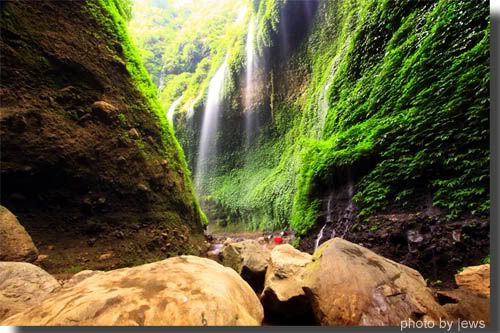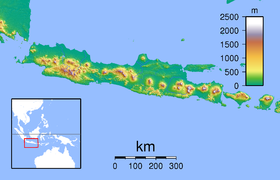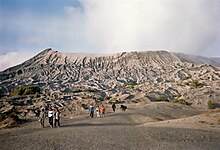Bromo Tengger Semeru National Park is located in East Java, Indonesia, to the east of Malang and to the southeast ofSurabaya, the capital of East Java.
| Bromo Tengger Semeru National Park | |
|---|---|
| Taman Nasional Bromo Tengger Semeru | |
IUCN category II (national park)
| |

Clockwise from lower left: the Hindu temple Poten, the steaming crater of Mount Bromo, erupting Mount Semeru, stately Mount Batok.
| |
| Location in Java | |
| Location | East Java, Indonesia |
| Nearest city | Malang |
| Coordinates | 8°1′S 112°55′ECoordinates: 8°1′S 112°55′E |
| Area | 50,276 hectares (124,230 acres; 502.76 km2) |
| Established | October 14, 1982 |
| Visitors | 61,704 (in 2007[1]) |
| Governing body | Ministry of Environment and Forestry |
| Website | bromotenggersemeru.org |
It is the only conservation area in Indonesia that has a sand sea,[2] the Tengger Sand Sea (Indonesian: Laut Pasir Tengger), across which is the caldera of an ancient volcano (Tengger) from which four new volcanic cones have emerged. This unique feature covers a total area of 5,250 hectares at an altitude of about 2,100 m.[2] The massif also contains the highest mountain in Java,[3] Mount Semeru (3,676 m), four lakes and 50 rivers.
The Tengger Sand Sea has been protected since 1919. The Bromo Tengger Semeru National Park was declared a national park in 1982.[4]
 |
| bromo mountain |
Volcanism[edit]
The volcanic complex of Tengger forms a condition where a new caldera of volcano forms inside a larger and more ancient caldera. There are five volcanoes inside the Tengger Caldera: Mount Bromo (2,329 m), Mount Batok (2,470 m), Mount Kursi (2,581 m), Mount Watangan (2,661 m), and Mount Widodaren (2,650 m). Mount Batok is the only peak that is no longer active, and is covered in casuarina (Indonesian: cemara) trees. Mount Widodaren, located beside Mount Batok, contains the cave Widodaren, which is considered sacred by local people.
The five volcanoes within the caldera are surrounded by a vast area of sand called the Tengger Sand Sea, which in turn is surrounded by a steep crater wall of the larger Tengger Caldera with height differences of about 200–600 meters. Other mountains around the Tengger caldera are: Mount Pananjakan (2,770 m) Mount Cemorolawang (2,227 m), Mount Lingker (2,278 m), Mount Pundak Lembu (2,635 m), Mount Jantur (2,705 m), Mount Ider-ider (2,527 m) and Mount Mungal (2,480 m). The peak of Mount Pananjakan is the most popular place to watch the entire volcanic complex of Tengger.[5]

Further south in the national park, there is another volcanic complex called the Semeru Group or Jambangan Group. This area contains the highest peak of Java, Mount Semeru (3,676 m). Other mountains within this area are Mount Lanang (2,313 m), Mount Ayek-ayek (2,819 m), Mount Pangonan Cilik (2,833 m), Mount Keduwung (2,334 m), Mount Jambangan (3,020 m), Mount Gentong (1,951 m), Mount Kepolo (3,035 m), and Mount Malang (2,401 m). The Semeru forest area has many rivers that are former lava lines from Mount Semeru. The Semeru group is considered to be very productive, producing volcanic matters such as lava, volcanic ash, and hot cloud and spreading it to the surrounding area. The lower area is surrounded with fertile rice fields.
Ecosystem[edit]
According to height and temperature differences, the forests within the area can be classified into three zones:
Sub-montane zone (750 – 1,500 m)[edit]
 |
| Madakaripura waterfall at Bromo Tengger Semeru National Park |
This zone is classified as a tropical rainforest. It can be found in the southern area of Semeru, East Semeru (Burno), and West Semeru (Patok Picis). This zone is dominated with plants of the families Fagaceae, Moraceae, Anacardiaceae, Sterculiaceae, and Rubiaceae. There are also liana trees, such as a variety from the genus Calamus, Piper, Asplenium, and Begonia, and other plants from the family Araceae, Poaceae, andZingiberaceae. There are also 225 species of orchid in this area.[6]



Montane zone (1,500 – 2,440 m)[edit]
Plant life is greatly reduced in this area. Most of the species that grow in this area are pioneer species. There are also some wooden plants such as cemara (Casuarina junghuhniana), mentinggi gunung (Vaccinium varingifolium), kemlandingan gunung (Albizia lophantha), acacia bark (Acacia decurrens) and bottom plants such as Javanese edelweiss or senduro (Anaphalis longifongila and Anaphalis javanica), Imperata cylindrica, Pterissp., Themeda sp. and Centella asiatica.[6]
The Tengger Sand Sea in Tengger Caldera is a special ecosystem. The area is covered in volcanic sedimentation of sand from Mount Bromo activities. The resulting area is believed to be the only known desert-like area in Indonesia. The Tengger Sand Sea has been protected since 1919.




Subalpine zone (above 2,400 m)[edit]
The flora that cover this area are mentinggi gunung (Vaccinium varingifolium) and cemara (Casuarina junghuhniana). Kemlandingan gunung (Albizia lophantha) and Javanese edelweiss can also be found growing in this zone. [6]
On Mount Semeru, there is no plant life above the altitude of 3,100 m. This zone is covered in loose sandstones.[6]
Flora and fauna[edit]


 Some endangered flora are protected in this park, such as Fagaceae, Moraceae, Sterculiaceae, Casuarina junghuhniana, Javanese edelweiss, and about 200 species of endemic orchids.
Some endangered flora are protected in this park, such as Fagaceae, Moraceae, Sterculiaceae, Casuarina junghuhniana, Javanese edelweiss, and about 200 species of endemic orchids.
There is a relatively small diversity of fauna in the Bromo Tengger Semeru National Park. There are about 137 species of birds, 22 species of mammals and 4 species of reptiles protected in the national park. Examples are besra, green peafowl, Javan rusa, Sumatran dhole, crab-eating macaque, marbled cat and Javan leopard.[2][7]
Culture[edit]

 For more details on this topic, see Tenggerese.
For more details on this topic, see Tenggerese.
The area in and around the park is inhabited by the Tengger people,[2] one of the few significant Hindu communities remaining on the island of Java. The local religion is a remnant from the Majapahit era and therefore quite similar to that on Bali but with even more animist elements. The Tengger people are believed to be descendents of the Majapahit empire and were driven into the hills after mass arrival in the area of Muslim Madurese in the 19th century.














0 komentar:
Post a Comment